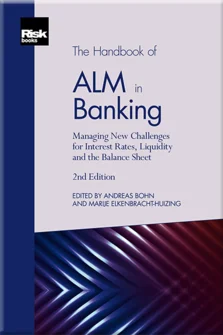Asset Encumbrance
Daniela Migliasso
Asset Encumbrance
Introduction
Bank Capital and Liquidity
ALM in the Context of Enterprise Risk Management
The New Basel Standards on IRRBB and Their Implications for ALM
Measuring and Managing Interest Rate and Basis Risk
The Modelling of Non-Maturity Deposits
Modelling Non-Maturing Deposits with Stochastic Interest Rates and Credit Spreads
Managing Interest Rate Risk for Non-Maturity Deposits
Replication of Non-Maturing Products in a Low Interest Rate Environment
Managing Mortgage Prepayment Risk on the Balance Sheet
Considerations for ALM in Low and Negative Interest Rate Environments
Credit Spreads
Hedge Accounting
Supervisory Views on Liquidity Regulation, Supervision and Management
Measuring and Managing Liquidity and Funding Risk
Managing Reserve Assets
Instruments for Secured Funding
Asset Encumbrance
Capital Management
A Global Perspective on Stress Testing
Reverse Stress Testing: Linking Risks, Earnings, Capital and Liquidity – A Process-Orientated Framework and Its Application to Asset–Liability Management
XVAs and the Holistic Management of Financial Resources
Optimal Funding Tenors
Funds Transfer Pricing in the New Normal
Balance-Sheet Management with Regulatory Constraints
Asset encumbrance occurs when the bank’s assets are used to secure creditors’ claims or credit-enhance any transaction.
In Europe, asset encumbrance began to be discussed in 2012, after bank funding structures started to shift towards more secured funding compared with the previous decade, owing to the financial crisis that started in 2007.
During the financial crisis years, the interbank unsecured market fell, finally dropping dramatically due to higher counterparty risk concerns. Consequently, banks increased the use of their assets as collateral, having the need to resort to more secured market issuances, particularly covered bonds, and public-sector funding sources in addition to repurchase agreement (repo) funding. At the same time, greater collateralisation resulted from trading activities and related risk mitigation, such as for derivatives and wider use of central counterparty clearing houses (CCPs).
Assets that are encumbered are obviously not available for any other use.
The resulting regulatory concern was that it could be too risky (not only at individual bank level) should asset encumbrance reach excessive percentages due to the different potential types of
Copyright Infopro Digital Limited. All rights reserved.
As outlined in our terms and conditions, https://www.infopro-digital.com/terms-and-conditions/subscriptions/ (point 2.4), printing is limited to a single copy.
If you would like to purchase additional rights please email info@risk.net
Copyright Infopro Digital Limited. All rights reserved.
You may share this content using our article tools. As outlined in our terms and conditions, https://www.infopro-digital.com/terms-and-conditions/subscriptions/ (clause 2.4), an Authorised User may only make one copy of the materials for their own personal use. You must also comply with the restrictions in clause 2.5.
If you would like to purchase additional rights please email info@risk.net











